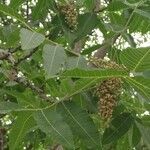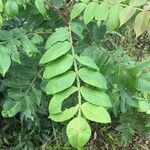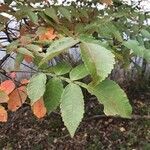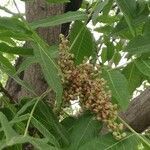Shrubs to trees, 2-10 m tall; branchlets ferruginous pubescent, lenticellate. Leaf blade sessile, imparipinnately compound; rachis broadly winged to wingless, ferruginous pubescent; leaflets (5-)7-13; leaflet blade ovate to oblong, increasing in size toward apex, 6-12 × 3-7 cm, adaxially dark green, sparsely pubescent or glabrescent, abaxially lighter green, glaucous, and ferruginous pubescent, base rounded to cuneate in terminal leaflet, margin dentate, often crenate, apex acute, lateral veins and reticulate venation impressed adaxially and prominent abaxially. Inflorescence many branched, densely ferruginous pubescent, male ones 30-40 cm, female ones shorter. Pedicel ca. 1 mm, minutely pubescent; flowers white. Male flowers: calyx minutely pubescent, lobes long ovate, ca. 1 mm, with ciliate margins; petals obovate-oblong, ca. 2 mm; stamen filaments ca. 2 mm, anthers ovoid, ca. 0.7 mm; disk annular; ovary reduced to absent. Female flowers: calyx lobes ca. 0.6 mm; petals elliptic-ovate, ca. 1.6 mm; staminodes much reduced; disk annular; ovary ovoid, ca. 1 mm, densely white pubescent, styles 3, stigma capitate. Drupe globose, slightly compressed, 4-5 mm in diam., mixed pilose and glandular-pubescent, red at maturity. Fl. Aug-Sep, fr. Oct.
A shrub. It loses its leaves during the year. It grows 2-4 m high. Its shoots are downy. The branches have spines. The leaves have leaflets along the stalk. The leaves are 40 cm long. There are 7-13 leaflets on a stalk. The leaflets are about 5-12 cm long by 2-5 cm wide. The leaves turn red in autumn. The flowers are white. They are in cone shaped clusters. The fruit are round. They are bright orange-red.






